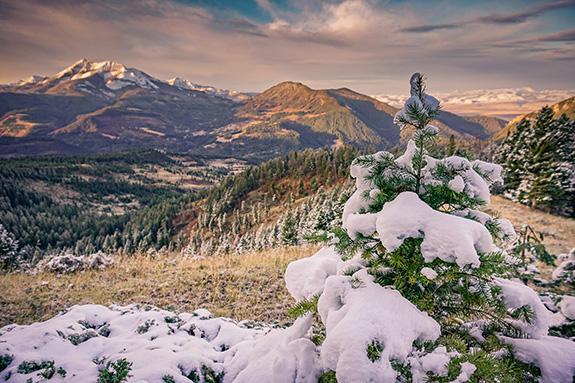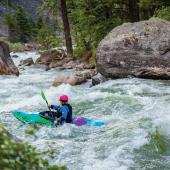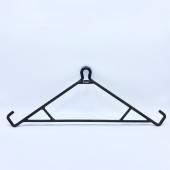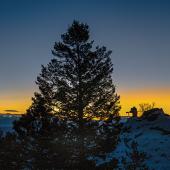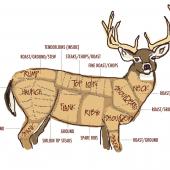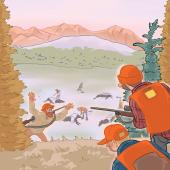Taking the High Road
Hunting mountainous terrain.
Treeline terminates at around 9,500 feet in the mountain range of southwestern Montana where I have hunted elk for more than four decades. From the location where my family camped when I was a teen, a patient observer with quality binoculars might spot elk feeding at dusk on a lofty ridge above our bivouac, where fine-stemmed, nutritious grass lured wapiti from the timber below.
That ridge, nearly 2,000 vertical feet above our camp, was the location of many elk kills, animals caught feeding on its spine in the wee light just before sunrise and after sunset. It also served as an ambush point for a contingent of cold-hardy cousins who huddled behind stunted pines or nubbles of stone to intercept animals crossing from one drainage to another to escape hunters below.
The youngest of three sons, in a family possessed of but one riding horse, I typically reached the ridge hiking behind a string of mounted hunters, dodging minefields of feces and attempting to stay upwind of flatulence. To reach the destination, we first hiked or rode downhill on the two-track below camp to reach a Forest Service trail. The path dropped into a deep ravine to cross a creek, then rose for two miles before veering sharply up a finger ridge to gain the wandering crest of the range.
I resented the hike with a passion. Not so much for the exertion and horse poo, for I was a wiry farm-kid, a miler on the track team, and supremely capable of matching footfalls with the iron-shod steeds burdened with my relatives. What I hated was sacrificing some 500 feet of elevation in the descent to the trail below camp.
One afternoon, while contemplating an evening hunt, I eyed the cliffy remnants of a landslide that had shorn away the face of the slope just opposite our camp, just beneath the backbone of the finger ridge leading to the more lofty heights on which we frequently hunted. What if, just what if, a fellow could find a route around the upper side of the slide. Perhaps he could reach our trail to the ridgeline without the misery of first going down to go up.
An hour later I angled from camp, leapt across the creek where it babbled through a phalanx of old, pale aspens, then ducked into the predominantly fir forest on its far side, nearly a mile above the crossing on the familiar trail below. Before entering the timber, I’d taken a bearing on the upper edge of the landslide. The slope was steep, but manageable. Toiling onward, I passed over an elk trail, angling modestly upward from right to left. The tangent of the hoof-tilled ribbon of soil amidst a sea of tightly-packed Douglas fir and lodgepole pine trees appeared on course with the cliffs demarcating the slide.
My boots turned intuitively onto the path of the ungulates. In short order I gained the edge of the earthen rift on the mountainside. A few steps before its precipice, the elk trail turned upward. I followed as it uncannily switched back and forth near the slide. Much sooner than I imagined, my boot-prints were tracking the finger ridge no more than a mile below its lordly counterpart at the roof of the range. For the next two decades I took this delightful little shortcut up the mountain and couldn’t help but smirk, just a little, when the sweaty, winded horses and their riders arrived well behind the hiker.
In my world, hunting in the mountains means navigating the terrain on foot or horseback, most frequently the former. There is an art and science to savvy travel in the mountains, something I began to appreciate with the discovery of my “shortcut.” The pertinence of the subject-matter seems directly proportional to a hunter’s age. Elk, the quarry which most frequently lures hunters to all those delightful ranges we enjoy in southwestern Montana, are master mentors to humans wishing to become more efficient mountain travelers. Unless spooked, the animals generally shun routes requiring them to move directly up or down a slope. They’re much more inclined toward the contours, on lines that gain or yield elevation in modest increments.
Slope, or the steepness of the terrain, should also influence human mobility. The science of speed hiking indicates a slope of ten degrees (an elevation gain of about 900 feet per mile) maximizes a person’s ability to gain both elevation and distance. A 20-degree slope (about 1,800 feet elevation gain per mile) dramatically increases physical effort to both ascend and descend the terrain and renders a hunter’s travel much less efficient. One exercise-physiology research project indicates the energy savings on the descent of a 20-degree slope is only about 25% over the very demanding ascent.
There is no experience akin to wandering the mountains, among elk pastures and aspens, on ridgetops and creek bottoms, in search of a favored quarry. A savvy travel strategy allows one to roam more expansively, and feel much better at the end of a long day.



